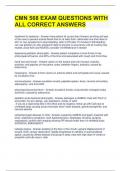CMN 568 EXAM QUESTIONS WITH
ALL CORRECT ANSWERS
treatment for epistaxis - Answer-have patient sit up and lean forward, pinching soft part
of the nose to prevent arterial blood flow for at least 5min; administer one time dose of
afrin or neo-synephrine to stop bleeding; refer to ER after 15 minutes if still bleeding;
can use gelfoam on site; polysporin daily to prevent re-occurance until all crusting has
healed; avoid ASA and NSAIDs; consider VonWillebrand if needed
diagnosing pediatric pharyngitis - Answer-patient complains of sore throat or has
pharyngeal erthyema; viral 90% of the time and associated with cough and rhinorrhea
hand foot and mouth - Answer-ulcers on the tongue and oral mucosa; vesicles,
pustules, and papules on the palms, soles, between fingers, buttocks; caused by
enterovirus
herpangina - Answer-2-3mm ulcers on anterior pillars and soft palate and uvula; caused
by coxsackie virus
mononucleosis - Answer-exudative tonsils; palpable spleen; fever; cervical and axillary
adenopathy; viral from EBV
pharyngoconjunctival fever - Answer-exudative tonsils; conjunctivitis; enlarged nodes
and fever; caused by adenovirus
pediatric acute bacterial pharyngitis - Answer-pathogen is GABHS; treat with PenV or
amoxicillin; for pcn allergy, use cephalexin, clinda, or azith
; if you do a rapid strep test in the office and its negative, follow up with C&S due to
untreated strep causing acute rheumatic fever/ heart disease, glomerulonephritis, and
cervical adenitis
retropharyngeal abscess in child - Answer-cuased by GABHS and staph; presents with
fever, respiratory symptoms, neck hyperextension, dysphagia, drooling, gurgling
respirations; confirm with imaging showing RP tissues wider than c4 vertebral body;
SURGICAL EMERGENCY
ludwigs angina - Answer-swelling of the floor of the mouth; upward dislpacememt of
tongue; fever; airway obstruction; rpaidly progresses to cellulitis of submandibular
space; caused by dental disease and group A strep; treat with high dose IV clinda or
ampicillin until c&s return; refer
,recurrent tonsillitis - Answer-child has 7 or more cases in 1 year; 5 per year for 2 years;
or 3 per year for 3 years
ankyloglossia - Answer-tongue tie; short lingual frenulum hinders protrusion of tongue;
causes feeding difficulties; refer to otolaryngologist
submucous palate - Answer-translucent zone in middle of the soft palate; absence of
bony protrusion in hard palate; referral needed for surgical repair; can cause persistent
MEE
pierre robin sequence - Answer-congenital malformation by triad of micrognathia, cleft
palate, and glossoptosis; EMERGENCY due to infringement of airway by tongue
keratoconjunctivitis sicca - Answer-Prevalent in older adults, especially women;
hypofunction of the lacrimal gland as we age; environmental factors can worsen; clinical
findings: dry, red eyes, foreign body sensation, excessive, mucus, secretion, decreased
tear formation, and photophobia; treatment is artificial tears, PRN
Hordeolum - Answer-Stye; localized infection in the gland of Zeis of eyelid; caused by
staph; tender, red, warm papillae on eyelid; topical abx
What are the emergent eye conditions of the adult? - Answer-Acute angle closure
glaucoma, anterior uveitis (iritis), scleritis, keratitis
Acute angle closure glaucoma - Answer-EMERGENCY; elevated IoP; risk factors are
shallow anterior chamber (associated with farsightedness) or history of topical/ oral
mydriatic use or eye surgery, family history, Inuits and Asians
Primary acute closure glaucoma - Answer-acute, sudden and severe closure of the
angle was very high I/O P (often 5 to 80 MM HG), decreased visual acuity, corneal
edema, pain, nausea, and vomiting
Clinical findings in acute closed angle glaucoma - Answer-Severe pain and rapidly
progressive loss of vision, halos around lights, acute photophobia, corneal haziness;
involved people will be moderately, dilated and unreactive to light, palpate for a
hardened globe due to elevated IOP; hallmark finding is IOP 50 to 100, corneal edema
Treatment for acute closed angle glaucoma - Answer-Single 500mg IV dose of
acetazalomide, then 250mg QID; osmotic diuretics
Keratitis - Answer-Inflammation of the cornea; caused by overnight contact use; clinical
findings: hazy cornea, and adjacent stromal abscess; pus in anterior chamber; can
either be bacterial or viral; GRITTY OR FORGEIN BODY SENSATION
, anticipatory guidance - Answer-Patient/family counseling which includes information,
advice, and suggestions about expected health-related life occurrences, health
maintenance, and preventive plans.
where should pediatric history information be obtained from? - Answer-both patient and
parent; obtain as much as possible from patient to give child a degree of control over a
potentially threatening situation
order of pediatric physical examination - Answer-1. inspection first, from afar; examine
skin color and work of breathing before beginning exam; establish trust; allow child to sit
in parents lap; defer otoscopic exam until last
when should eyes and ears be examined? - Answer-during every health visit
3 components of vision assessment - Answer-- visual inspection of eyes/eyelids
- alignment of eyes
- visual acuity
birth to age 3 ophthalmic exam includes: - Answer-- eye history
- vision assessment
- inspection of eyelids and eyes
- pupil examination
- ocular mobility
- red reflex check
age 3 and up ophthalmic exam includes: - Answer-- eye history
- vision assessment
- inspection of eyelids and eyes
- pupil examination
- ocular mobility
- red reflex check
visual acuity test with eye chart; classes should be worn if prescribed and record data
as "corrected"
assessing newborn visual acuity - Answer-should be able to briefly track mother's face
or brightly colored object within an hour after birth (fixation reflex not developed for
several weeks); dont talk while assessing vision, baby may look toward sound rather
than visual stimulus
when patient presents with eye condition (infection, injury, etc), what do you check first?
- Answer-visual acuity; UNLESS there is chemical injury to eye, then you should irrigate
first and refer to ophthalmologist; when there is decreased acuity, also refer to
ophthalmologist
what is the visual acuity of a newborn? - Answer-20/200-20/400; acuity reaches adult
level of 20/20 by age 5




